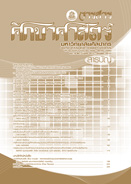การพัฒนาชุดบทเรียนออนไลน์ เรื่อง วิธีการเรียนการสอนอีเลิร์นนิงสำหรับผู้สอนในสถาบันการศึกษา
Main Article Content
บทคัดย่อ
ผลการวิจัยพบว่า
1 เนื้อหาวิธีการเรียนการสอนอีเลิร์นนิงที่เหมาะสมสำหรับนำไปพัฒนาเป็นสื่อชุดบทเรียนออนไลน์เรื่อง วิธีการเรียนการสอนอีเลิร์นนิง ประกอบด้วยเนื้อหา 7 ชุดบทเรียน ได้แก่ ชุดบทเรียนที่ 1 ความรู้พื้นฐานในการเรียนการสอนออนไลน์ (Fandamental of Online Instruction) ชุดบทเรียนที่ 2 การสอนแบบบรรยาย (e-Pedagogy : Lecture Learning) ชุดบทเรียนที่ 3 การสอนแบบอภิปราย (Discussion Based Learning) ชุดบทเรียนที่ 4 การสอนโดยใช้ปัญหาเป็นหลัก (Problem Based Learning) ชุดบทเรียนที่ 5 การสอนแบบโครงการ (Project based Learning) ชุดบทเรียนที่ 6 การสอนโดยใช้สถานการณ์จำลอง และเกม (Games Simulation Learning) ชุดบทเรียนที่ 7 การสอนแบบกรณีศึกษา (Case-based Learning) และมีข้อกำหนดในแต่ละชุดบทเรียน ประกอบด้วยลักษณะของบทเรียน ได้แก่ 1) เป็นบทเรียนสำหรับการเรียนออนไลน์เต็มรูปแบบ (Fully online) 2) เป็นบทเรียนที่ผู้เรียนศึกษาได้ด้วยตนเอง (Self pace Learning) 3) บทเรียนแต่ละชุดผู้เรียน สามารถเลือกเรียนชุดใดก่อนหลังได้ตามความสนใจ 4) ความยาวเนื้อหาเพื่อการสอนอย่างน้อยชุดละ 6-9 ชั่วโมงการสอน 5) สื่อการสอนภายในบทเรียนทุกชุดมีการนำเสนอในรูปแบบมัลติมีเดียได้แก่ ข้อความ เสียงบรรยายประกอบ ภาพประกอบ และวิดีโอคลิป 6) มีแบบทดสอบประเมินผลการเรียนทั้งก่อนเรียนและหลังเรียนครบทุกชุดบทเรียน
2. ผลการวิเคราะห์หาประสิทธิภาพของสื่อชุดบทเรียนออนไลน์ เรื่อง วิธีการเรียนการสอนอีเลิร์นนิง พบว่า มีประสิทธิภาพตามเกณฑ์ (E1/E2) ที่กำหนด ได้ค่า E1 เท่ากับ 80.03 ค่า E2 เท่ากับ 72.52 และผลการประเมินคุณภาพสื่อโดยผู้เชี่ยวชาญ พบว่า คุณภาพสื่อมีความเหมาะสมในระดับมาก ( = 4.25, S.D. = 0.18)
3. การเปรียบเทียบผลการเรียนรู้ก่อนเรียนกับหลังเรียนด้วยสื่อชุดบทเรียนออนไลน์ เรื่อง วิธีการเรียนการสอนอีเลิร์นนิง พบว่า คะแนนเฉลี่ยหลังเรียนสูงกว่าก่อนเรียนอย่างมีนัยสำคัญทางสถิติที่ระดับ .05
4. ความคิดเห็นของผู้เรียนที่เรียนด้วยสื่อชุดบทเรียนออนไลน์ เรื่อง วิธีการเรียนการสอนอีเลิร์นนิง พบว่า ค่าเฉลี่ยความคิดเห็นต่อสื่อชุดบทเรียนออนไลน์อยู่ในระดับดี ( = 4.06, S.D. = 0.38)
The Development of Online Learning packget on e-Learning Pedagogy (e-Pedagogy) Course for Instructors in Educational Institutes
The purposes of this research were: 1) to study contents, theories and practices for develop e-Learning pedagogy (e-Pedagogy) courseware, 2) to develop online learning package on e-Learning pedagogy course for instructors in educational institutes, 3) to compare learning achievement pretest and posttest of online learning package on e-Learning pedagogy course and, 4) to study students opinions on online learning package on e-Learning pedagogy course. The research simple consisted of 33 graduate students in the faculty of education, Silpakorn university of the academic year 2011. The research instruments were 1) focus group disscustion item 2) online learning package on e-Learning pedagogy course for instructors in educational institutes 3) learning achievement tests, and 4) questionnaire of evaluation students opinions. Data were analyzed by using mean, standard deviation, and t-test dependent statistics.
The research found;
1. The online learning package on e-Learning pedagogy course included the 7 courseware contents : 1) fundamental of online instruction, 2) e-Pedagogy: lecture learning, 3) discussion-based learning, 4) problem-based learning, 5) project-based learning, 6) games and simulation learning, and 7) case-based learning. The features of each courseware were: 1) fully online course, 2) self-paced leering course, 3) non-linear course, 4) 6-9 study-hour course. Contents of each course consisted of 1) objectives, 2) theories and applications in online teaching, 3) learning activities, 4) interactive activities between students and contents, and between students and instructors, 5) suggestion of appropriate internet tools, 6) suggestion on how to evaluate learning achievement. Each course consisted of text, audio, illustrations, and video clips, and learning achievement test. The result of quality evaluation of the online courseware on e-Learning pedagogy course by the content experts was good ( = 4.25, S.D = 0.18)
2. The efficiency (E1/E2) of the online learning package on e-Learning pedagogy course was E1 = 80.22 E2 = 84.22
3. The compare learning achievement of post-test higher than pre-test. t-test showed statistically significant difference at .05.
4. The students opinions application has good level positive toward the online learning package on e-Learning pedagogy course ( = 4.06, S.D. = 0.38)

